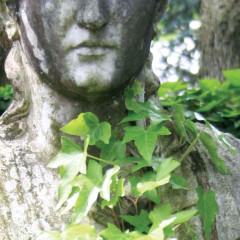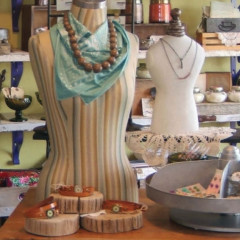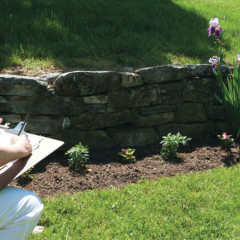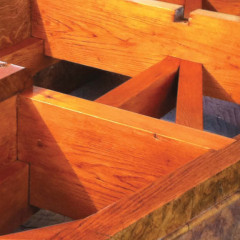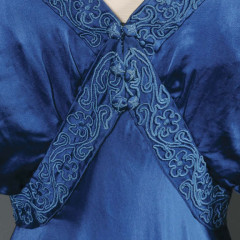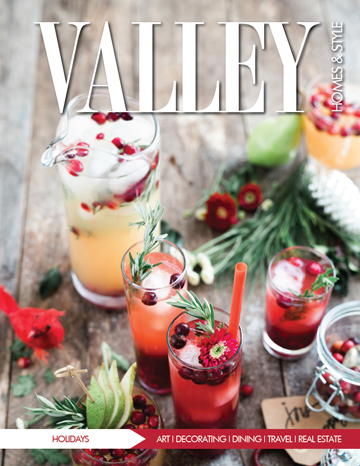Entwined In Vines
by Mary Stickley-Godinez I really love to use vines in my gardens. Whether draping a wall or arbor, winding up a tree, or covering a not-so-pretty view, these plants have numerous uses in the garden. And because there are so many uses for these workhorses there is there is no excuse. Every garden has a spot and a need for at least one. All gardens need some verticality—something that draws the eye upward to give the space more depth and interest. Including a vine-draped arbor, or even a simple post with a circling vine, adds just the right exclamation point to a garden bed. There is also something about a draping vine that just brings romance and softness to an area. Viewing the silhouette of that drapery against a blue sky, across a fence, or backdropped by shrubs, provides beautiful garden scenes for your eyes no matter which direction you look. The best gardens also contain small, surprising, intimate spaces—little, cozy, spots that the visitor discovers by chance. Vines work really well to create walls of privacy for these areas. Vines are also perfect to create quick screening. They grow fast to cover walls, fences or even posts to provide a quick surface of green to hide whatever ugly is behind it. I also love to use vines at the top of a steep slope. The vines are trained downward instead of up. It sounds a bit odd, but it is very effective and helps hold soils to prevent erosion. As an added benefit, when they bloom the flowers are down where you can see them instead of out of sight at the top of a high beam. This trick also works really well to soften the expanse of a retaining wall. There are both annual and perennial vines. Annuals are perfect for a space that needs really fast coverage. They also usually bloom the majority of the season and so can bring a lot of color to a garden. Perennials have the advantage of coming back year after year. These are good to plant to create a “roof” on an arbor or can be used to add some structural interest. These will also bloom, but they usually have a shorter season of color. And, keep in mind that some vines are grown for the beauty of the foliage instead of the flowers. Sometimes, however, you need coverage year round. There are evergreen vines that stay green throughout the season. Others grow so vigorously that the mass of stems can provide the screening even though they are bare of leaves. Don’t be afraid to mix and match some of...
The Purple Fern
A guilty pleasure among the bustle of Winchester by Victoria L. Kidd photos by Lauri Bridgeforth “It doesn’t get much more creative than this,” says Purple Fern customer Monica Singh-Smith as she digs through the array of silver rings fashioned out of vintage spoons. Smith is a regular, like many others who have come to see the little store on Featherbed Lane in Winchester as a guilty pleasure. Shoppers are drawn to the store partly because of its inviting atmosphere and partly because it carries a range of products and gifts not available anywhere else. It’s the vision of Sarah Garman, a well-known local photography and “creative” who has established the shop as not only a means to make a living but also as an outlet for her artistic pursuits. Garman makes much of what is sold in the store, as she has since it opened in 2008. She says that her creativity is spread across a broad spectrum of interests. “One week you’ll see me in here making wind chimes,” she says. “The next I’ll make jewelry, and the week after that maybe cards or something else. I love lots of things. It’s really just a matter of what I am inspired to create.” Customers often find her seated behind the cash register and singing as she works on something that will eventually make its way to the store’s shelves. Those shelves hold items from local artisans as well as fair trade items from makers around the world. Fair trade is a term used to describe a system of bringing products to the market that have been produced by artisans who are paid a living wage for their work. Fair trade is a movement that is anti-slavery and anti-child labor. It supports environmental conservation and empowers women and minorities in the developing world. For Garman, carrying a range of fair trade products is a matter of conscience. “I love the fair trade concept. I think it’s nice that people get paid what they are worth,” she explains. “They put all of this time into something, and it’s something that has a value that should be reflected in what they get paid for the work. Having these items available means that people can shop globally at a local store.” Her fair trade merchandise has something in common with items she sells on consignment from local and regional artists, crafters and makers. She believes that these items—which are often one-of-a-kind — make great gifts or serve as a nice way to treat one’s self to something special. “These things are really unique and special because they are made by hand...
Flashes of Inspiration
Artist shares personal sketching journals through publication by Joseph Weagley photos by Monika Wertman Kathleen A. Backus Renninger is an artist, author and graphic designer. She has been painting, writing and illustrating from her home in Blue Ridge Summit, Pa., since she and her husband, Don Renninger, settled in the mountaintop community more than 35 years ago. Their home includes a studio where Kathleen explores and expresses the creativity that has always been a part of her life. “From the time I could hold a crayon, I was always drawing,” Renninger says, recalling that she used a red crayon to draw her first mural on the living room wall just above the baseboard when she was a little girl. Although Kathleen’s mother taught her that it was inappropriate to draw stick figures on the wall, she did encouraged Kathleen to express her creativity. An aunt and neighbor, Nell Metzgar, provided support and encouragement with gifts of art supplies and creative kits. As Kathleen grew up, she continued her journey to self-taught artist. “I don’t have any formal training in art and I’ve never taken a class,” she says, explaining that during her teenage years she enjoyed drawing and painting. She also began writing poetry. After high school, she attended Williamsport Area Community College in Williamsport, Pa., and took a two years course in sign painting. The course taught Kathleen the basics of graphic design, including layout and lettering. Kathleen’s sign painting teacher was also an artistic influence. “He was an artist and he got me interested in old structures and doing pen and ink,” she says. “He didn’t give me any instruction, but sparked my interest.” While in college, Kathleen began to draw portraits. As her confidence grew, she taught herself calligraphy. After getting married and moving to Blue Ridge Summit, Kathleen accepting commissions to do paintings of houses and pets. She also worked as a freelance illustrator of greeting cards for almost five years. The next stage of her creative journey was inspired by several friends and their hobby of model railroading. Kathleen saw their model train layouts that included tracks, model buildings and artificial landscapes. She also noticed the details that make the train layouts look realistic. “It was like a miniature world,” Renninger says. “That got me interested.” To learn more, Kathleen began visiting the showroom of Mainline Hobby Supply, a business in Blue Ridge Summit that specializes exclusively in model railroading supplies. Kathleen became acquainted with the customers and learned more about train layouts. Kathleen began custom painting model trains with an airbrush. She experimented with model buildings to make them appear more realistic. Some...
Conserving Our History
The MSV’s beautiful Broadwood piano by Victoria L. Kidd As an object, it’s simply enchanting, even in its current disassembled state. It’s longer than any piano the average person will have ever seen, giving it a commanding presence. The case is veneered with a strongly patterned burl walnut that has a distinctive swirly appearance entreating the eye to get lost while following its curves. Its ebony and ivory keys date to a period prior to the global consciousness of how the ivory trade has imperiled the majestic elephants from which the material is stolen. Its curves beg to be touched. Essentially, it fills the room, as it has since it was produced in the 1800s. Through the careful efforts of Sue Manley and Israel Schossev of Israel Schossev Pianos, this beautiful object will once again be ready to play when it returns to its home at the Museum of the Shenandoah Valley. The MSV’s Broadwood piano was once a central piece of the “country house” narrative that museum benefactor Julian Wood Glass Jr. and his long-term partner R. Lee Taylor strived to convey through the appointments and decorations of the Glen Burnie House, a beautiful showplace surrounded by six acres of formal gardens. Glass, a man who loved entertaining friends at his home, established the Glass-Burnie Foundation to make certain his collections, the house, and nearby Rose Hill (the Glass ancestral homestead) would continue to be a place for public enjoyment after long his death in 1992. The Glen Burnie Historic House and Gardens opened in 1997. Lee Taylor (who lived in an apartment on the grounds following the dissolution of his relationship with Glass in the 1970s) was curator of gardens until his death in 2000. The museum would open on the grounds in 2005 with the purpose of presenting the impressive collection of objects Glass left behind. Among those objects is a piano that Lee and Julian believed was produced by English piano manufacturer Broadwood and Sons in the 1820s. According to A. Nicholas Powers, Curator of Collections for the MSV, that assumption is most likely incorrect. A conservator at Colonial Williamsburg dated it to around 1875, making it a centennial piece. While its true age is a mystery, what is known is that the piece was purchased on July 8, 1905 for $150 from C. G. Sloan & Co., an auction house in Washington, D.C. Powers conveys that Katherine Glass Greene purchased the piano for use at the Fort Loudoun Seminary, an organization that is extremely important to the history of women’s education in the Valley. “We have a photograph of the piano at the seminary,”...
Fashion Archives
by Cheryl M. Keyser These days the national dress – even the international dress – seems to be jeans, sweats and sneaks, but it is amazing to see what people wore in previous times. Present-day society could barely survive in the multiple layers of underclothing and outer clothing worn by both men and women, and we are stunned over fashions from the past made of linen and lace, silk and satin. Even that modest fabric – muslin – takes a bow among all the other fancy garments. A prime place to immerse oneself in the history of clothing is the Fashion Archives at Shippensburg University where a wealth of items are on display that tell a great deal about the way in which what we wear has evolved. Shippensburg may seem an odd place to be a home to fashion, but its appearance here can be traced to the interest of the late Dr. Elizabeth Thompson. It started simple – just a rack of vintage clothing in her office. An innovative teacher, Thompson ventured into popular culture with, among others, a course which consisted of her students interviewing local people from various walks of life: a piano tuner, an insurance agent, a policewoman, an English professor. She recognized the role clothing played in society so it was not unusual for her to have a stash tucked away in a corner. Now some 35 years later, her dream of an independent facility has come to fruition as the Fashion Archives moves into a new home on campus, the Davis House. Here is gathered a 15,000 item collection that ranges from the 1750s to the early 1900s. Included are both clothing and accessories, items worn by middle and working individuals – men, women and children – pieces from noted designers as Chanel, Scaasi and Trigere, as well as more rare as Victorian corsets and Chinese binding shoes. The collection is now under the dedicated purview of Dr. Karin J. Bohleke. Bohleke did not follow a direct path to her vast knowledge of clothing, but it was one which started early. “Dressmaking is in my blood, my great grandfather was a professional tailor in Oslo, Norway, and textiles have been a part of my life.” Her mother taught her how to knit at 3, and by the next year she was doing embroidery. “I have been operating a sewing machine since I was seven and I would go to the library and check out books on Henry VIII to make clothing for my dolls.” So adept is she at understanding the structure of a garment, that she can look at a piece...

